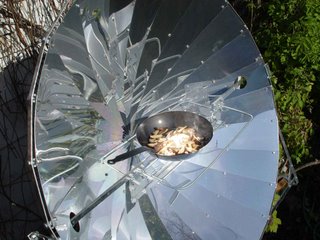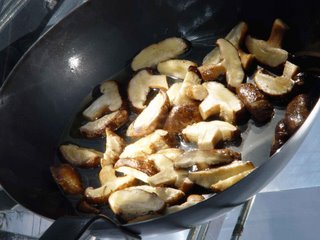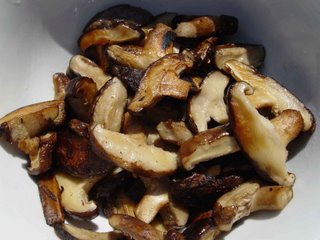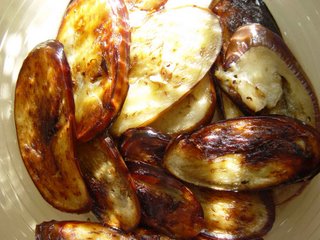Sun Baked Lasagna
Once again, I'm returning to a staple dish from my father's kitchen. Lasagna has graced our Saturday night table on autumn and winter evenings for many years.
Lasagna is literally an ancient dish, dating back to Roman cuisine. It was also eaten in the court of King Richard the Lion Heart, who is recorded to have feasted on a similar dish called "loseyns." (lasan) Perhaps the recipe was passed down to Richard? Thank goodness the original meaning of the word was not. The word "lasagna" actually comes from the ancient Greek word for chamber pot! (an ancient dish indeed!) The Romans somehow misappropriated the word to mean a cooking pot. Whatever the origins of lasagna, the original version did not use tomatoes, which were not introduced to Europe until Spanish conquistadores brought back tomato plants from Mexico and the Andes.
My father now makes his own tomato sauce from the organic, heirloom tomatoes he grows in the back garden, sprouted from the first seeds I gave him. We save our own tomato seeds, and we even provide them to others. It's his home made sauce that I'll be using today, which includes San Marzano, Caspian Pink, and even some Black Plum tomatoes. The peppers, garlic and onions he uses were all grown in his garden.
That said, my lasagna is a bit different from dad's recipe. Where he used ground beef, in the traditional way, my lasagna is 100% vegetarian, with eggplant and brown Crimini mushrooms substituting for beef. I still eat a bit of meat, though I'm trying to wean myself off of it. Meat eating, as it's practiced in North America at least, is not sustainable, and uses a tremendous amount of energy we could be saving.
For every food calorie we eat, 10 calories of fossil fuel energy are required to produce it. That's before we cook it.
Today, I'm going to make a healthy lasagna and cook it (with the exception of the noodles to save time) using 100% renewable solar energy. Because of the local nature of most of the ingredients and the free fuel used to cook the food, think of this as a sustainable lasagna, with low "embodied energy."
My lasagna includes simple, healthy ingredients, most locally produced, (in southern Ontario) with the exception of the pasta (Canada), olive oil (Greece) and the ricotta cheese (Quebec).
Catelli, healthy harvest whole wheat lasagna noodles
A large Mason jar of Dad's homemade pasta sauce
A tub of soft ricotta cheese
Mozzarella cheese
Crimini mushrooms
Two Chinese eggplants
Dad's home grown garlic
salt and pepper
First step in preparing lasagna is the "mise en place." Everything needs to be "put in its place." This is a dish that requires organization and a process carried out in a series of steps. Mozzarella needs to be grated. Noodles need to be cooked, mushrooms and eggplant cleaned and chopped. And of course the Sun Cook solar cooker must be correctly placed in the sun to pre-heat.
Today I'm also going to use my El Solito parabolic solar barbecue to fry the mushrooms and eggplant before these ingredients go into the lasagna.

Mushrooms go into a light weight steel frying pan from de Buyer in France, which has been making professional cookware since 1840.

Note how the mushrooms have browned. The sun did that.

Eggplant gets a similar treatment.

Keep in mind: these results are achieved in late October, 2006 in Toronto Canada, using local, concentrated sunlight. Note how crispy the eggplant turned out. We can fry foods outside, all year round in Toronto, using nothing but the focused energy of the sun. All we need is a sunny day.
These flavours of the fried eggplant and garlic will blend into the lasagna for a much more sophisticated taste than simply adding raw eggplant.

Once the veggies and noodles are cooked, I take my noodles and create a layer directly onto a lightly oiled baking dish, that comes with the Sun Cook. Spread tomato sauce thinly, then layer ricotta cheese and mushrooms.
The next layer is pasta, ricotta cheese, the eggplant and some mozzarella.

The final layer contains the last of the pasta, tomato sauce and a good coating of mozzarella.
Now the lasagna goes into the oven.

After 2 hours, I took out the lasagna and showed it to my neighbour Barb, who was cleaning up her garden after the summer.

It was an opportunity to thank Barb for her help. This lasagna was prepared on Barb's garden shed, which sits on the other side of the fence we share. Barb is kind enough to allow me to user her backyard for solar cooking sometimes, because it's sunnier than my own. Barb also gave me some fresh carrots that she grew.
It's important to remember the value of community and the maintenance of good relations with our neighbours. In the "post oil" future, we will rely on our local neighbours for support and assistance as many of the services and goods we currently purchase on the market will have to be re-created locally. I'm lucky to have a neighbour like Barb, who just happens to be the aunt of one of my oldest friends. I moved into the house next door to Barb in a complete coincidence.
We can't always choose our neighbours, but we can certainly choose to at least say "hello" to them, and hopefully share the bounty of nature with them too.
Lasagna is literally an ancient dish, dating back to Roman cuisine. It was also eaten in the court of King Richard the Lion Heart, who is recorded to have feasted on a similar dish called "loseyns." (lasan) Perhaps the recipe was passed down to Richard? Thank goodness the original meaning of the word was not. The word "lasagna" actually comes from the ancient Greek word for chamber pot! (an ancient dish indeed!) The Romans somehow misappropriated the word to mean a cooking pot. Whatever the origins of lasagna, the original version did not use tomatoes, which were not introduced to Europe until Spanish conquistadores brought back tomato plants from Mexico and the Andes.
My father now makes his own tomato sauce from the organic, heirloom tomatoes he grows in the back garden, sprouted from the first seeds I gave him. We save our own tomato seeds, and we even provide them to others. It's his home made sauce that I'll be using today, which includes San Marzano, Caspian Pink, and even some Black Plum tomatoes. The peppers, garlic and onions he uses were all grown in his garden.
That said, my lasagna is a bit different from dad's recipe. Where he used ground beef, in the traditional way, my lasagna is 100% vegetarian, with eggplant and brown Crimini mushrooms substituting for beef. I still eat a bit of meat, though I'm trying to wean myself off of it. Meat eating, as it's practiced in North America at least, is not sustainable, and uses a tremendous amount of energy we could be saving.
For every food calorie we eat, 10 calories of fossil fuel energy are required to produce it. That's before we cook it.
Today, I'm going to make a healthy lasagna and cook it (with the exception of the noodles to save time) using 100% renewable solar energy. Because of the local nature of most of the ingredients and the free fuel used to cook the food, think of this as a sustainable lasagna, with low "embodied energy."
My lasagna includes simple, healthy ingredients, most locally produced, (in southern Ontario) with the exception of the pasta (Canada), olive oil (Greece) and the ricotta cheese (Quebec).
Catelli, healthy harvest whole wheat lasagna noodles
A large Mason jar of Dad's homemade pasta sauce
A tub of soft ricotta cheese
Mozzarella cheese
Crimini mushrooms
Two Chinese eggplants
Dad's home grown garlic
salt and pepper
First step in preparing lasagna is the "mise en place." Everything needs to be "put in its place." This is a dish that requires organization and a process carried out in a series of steps. Mozzarella needs to be grated. Noodles need to be cooked, mushrooms and eggplant cleaned and chopped. And of course the Sun Cook solar cooker must be correctly placed in the sun to pre-heat.
Today I'm also going to use my El Solito parabolic solar barbecue to fry the mushrooms and eggplant before these ingredients go into the lasagna.

Mushrooms go into a light weight steel frying pan from de Buyer in France, which has been making professional cookware since 1840.

Note how the mushrooms have browned. The sun did that.

Eggplant gets a similar treatment.

Keep in mind: these results are achieved in late October, 2006 in Toronto Canada, using local, concentrated sunlight. Note how crispy the eggplant turned out. We can fry foods outside, all year round in Toronto, using nothing but the focused energy of the sun. All we need is a sunny day.
These flavours of the fried eggplant and garlic will blend into the lasagna for a much more sophisticated taste than simply adding raw eggplant.

Once the veggies and noodles are cooked, I take my noodles and create a layer directly onto a lightly oiled baking dish, that comes with the Sun Cook. Spread tomato sauce thinly, then layer ricotta cheese and mushrooms.
The next layer is pasta, ricotta cheese, the eggplant and some mozzarella.

The final layer contains the last of the pasta, tomato sauce and a good coating of mozzarella.
Now the lasagna goes into the oven.

After 2 hours, I took out the lasagna and showed it to my neighbour Barb, who was cleaning up her garden after the summer.

It was an opportunity to thank Barb for her help. This lasagna was prepared on Barb's garden shed, which sits on the other side of the fence we share. Barb is kind enough to allow me to user her backyard for solar cooking sometimes, because it's sunnier than my own. Barb also gave me some fresh carrots that she grew.
It's important to remember the value of community and the maintenance of good relations with our neighbours. In the "post oil" future, we will rely on our local neighbours for support and assistance as many of the services and goods we currently purchase on the market will have to be re-created locally. I'm lucky to have a neighbour like Barb, who just happens to be the aunt of one of my oldest friends. I moved into the house next door to Barb in a complete coincidence.
We can't always choose our neighbours, but we can certainly choose to at least say "hello" to them, and hopefully share the bounty of nature with them too.
